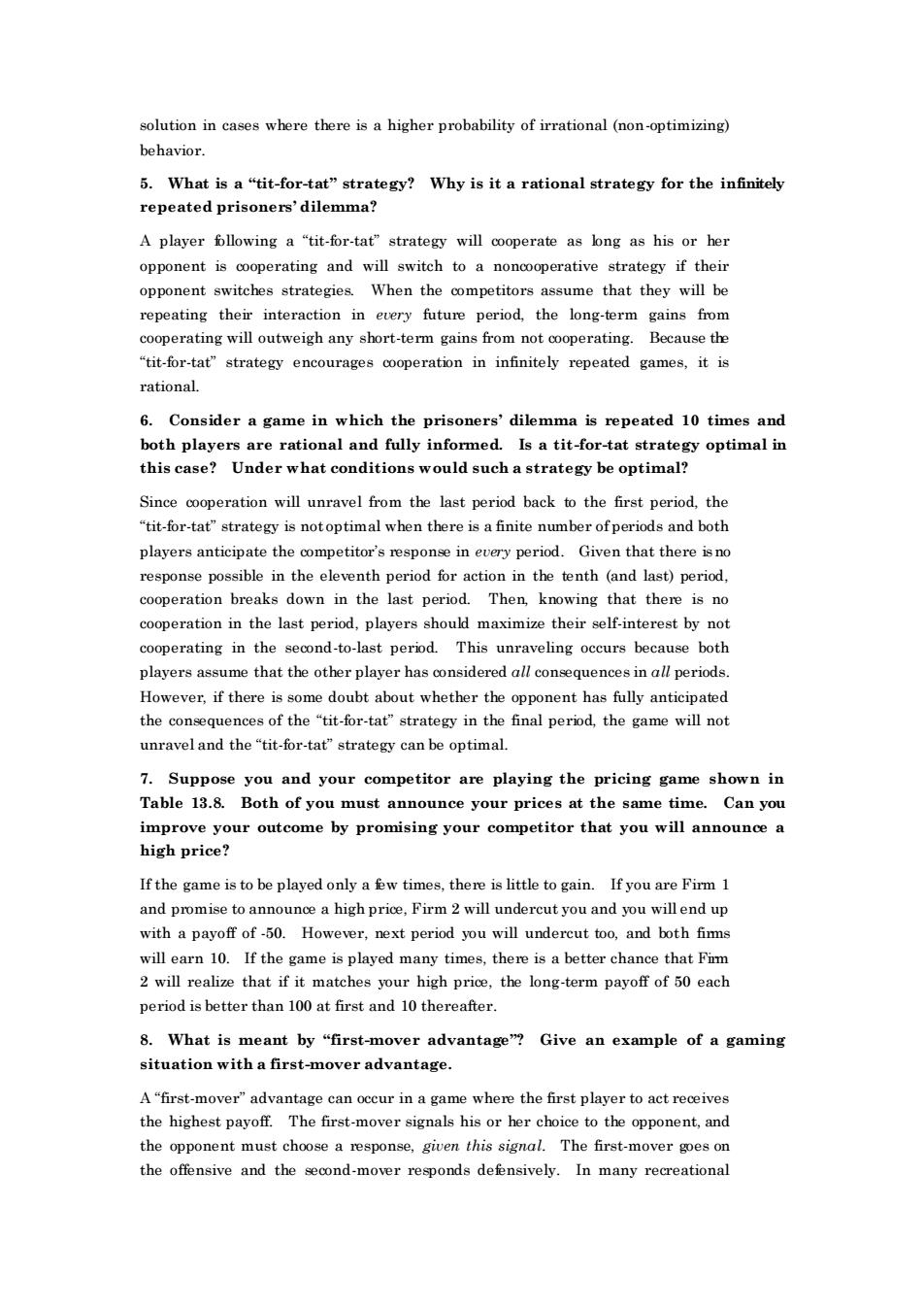正在加载图片...

solution in cases where there is a higher probability of irrational (non-optimizing) behavior. 5.What is a"tit-for-tat"strategy?Why is it a rational strategy for the infinitely repeated prisoners'dilemma? A player ollowing a "tit-for-tat"strategy will cooperate as bng as his or be opponent is cooperating and will switch to a noncooperative strategy if their opponent switches strategies.When the competitors assume that they will be repeating their interaction in every future period.the long-term gains from erating will outweigh anysort-tem gains from not operating Because the -tat strategy encourages cooperation in infinitely repeated games,it is rational 6.Consider a game in which the prisoners'dilemma is repeated 10 times and both players are rational and fully informed.Is a tit-for-tat strategy optimal in this case?Under what conditions would such a strategy be optimal? Since cooperation will unravel from the last period back to the first period,the "tit-for-tatstrategy is notoptimal when there is a finite number of periods and both players anticip ate the competitor's in every period G iven tha at there is response possible in the eleventh period for action in the tenth (and last)period cooperation breaks down in the last period.Then,knowing that there is no cooperation in the last period,players should maximize their self-interest by not However,if there is some doubt about whether the opponent has fully anticipated the consequences of the "tit-for-tat"strategy in the final period,the game will not unravel and the"tit-for-tat"strategy can be optimal. 7.Suppose you and your competitor are playing the pricing game shown in Table 13.8.Both of you must announce your prices at the same time.Can you rove by promising you competitor that you If the game is to be played only aw times,there is little to gain.If you are Firm and promise to announce a high price.Firm 2 will undercut you and you will end up with a payoff of-50.However,next period you will undercut too,and both fims will earn 10.If the game is played many times,there is a better chance that Fim 2 will realize that if it high p e.the long-term payoff of 50 each period is better than 10at first and 10 thereaft 8.What is meant by "first-mover advantage"?Give an example of a gaming situation with a first-mover advantage. A "first-mover"advantage can occur in a game where the first player to act receives the highest payoff.The first-mover signals his or her choice to the opponent,and the opponent must choose a response.given this signal.The first-mover goes on the offensive and the second-mover respo onds defensively.In many recreational solution in cases where there is a higher probability of irrational (non-optimizing) behavior. 5. What is a “tit-for-tat” strategy? Why is it a rational strategy for the infinitely repeated prisoners’ dilemma? A player following a “tit-for-tat” strategy will cooperate as long as his or her opponent is cooperating and will switch to a noncooperative strategy if their opponent switches strategies. When the competitors assume that they will be repeating their interaction in every future period, the long-term gains from cooperating will outweigh any short-term gains from not cooperating. Because the “tit-for-tat” strategy encourages cooperation in infinitely repeated games, it is rational. 6. Consider a game in which the prisoners’ dilemma is repeated 10 times and both players are rational and fully informed. Is a tit -for-tat strategy optimal in this case? Under what conditions would such a strategy be optimal? Since cooperation will unravel from the last period back to the first period, the “tit-for-tat” strategy is not optimal when there is a finite number of periods and both players anticipate the competitor’s response in every period. Given that there is no response possible in the eleventh period for action in the tenth (and last) period, cooperation breaks down in the last period. Then, knowing that there is no cooperation in the last period, players should maximize their self-interest by not cooperating in the second-to-last period. This unraveling occurs because both players assume that the other player has considered all consequences in all periods. However, if there is some doubt about whether the opponent has fully anticipated the consequences of the “tit-for-tat” strategy in the final period, the game will not unravel and the “tit-for-tat” strategy can be optimal. 7. Suppose you and your competitor are playing the pricing game shown in Table 13.8. Both of you must announce your prices at the same time. Can you improve your outcome by promising your competitor that you will announce a high price? If the game is to be played only a few times, there is little to gain. If you are Firm 1 and promise to announce a high price, Firm 2 will undercut you and you will end up with a payoff of -50. However, next period you will undercut too, and both firms will earn 10. If the game is played many times, there is a better chance that Firm 2 will realize that if it matches your high price, the long-term payoff of 50 each period is better than 100 at first and 10 thereafter. 8. What is meant by “first-mover advantage”? Give an example of a gaming situation with a first-mover advantage. A “first-mover” advantage can occur in a game where the first player to act receives the highest payoff. The first-mover signals his or her choice to the opponent, and the opponent must choose a response, given this signal. The first-mover goes on the offensive and the second-mover responds defensively. In many recreational